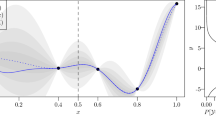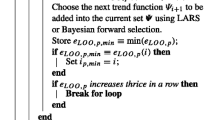Abstract
The Kriging surrogate model, which is frequently employed to apply evolutionary computation to real-world problems, with a coordinate transformation of the design space is proposed to improve the approximation accuracy of objective functions with correlated design variables. The coordinate transformation is conducted to extract significant trends in the objective function and identify the suitable coordinate system based on either one of two criteria: likelihood function or estimated gradients of the objective function to each design variable. Compared with the ordinary Kriging model, the proposed methods show higher accuracy in the approximation of various test functions. The proposed method based on likelihood shows higher accuracy than that based on gradients when the number of design variables is less than six. The latter method achieves higher accuracy than the ordinary Kriging model even for high-dimensional functions and is applied to an airfoil design problem with spline curves as an example with correlated design variables. This method achieves better performances not only in the approximation accuracy but also in the capability to explore the optimal solution.














Similar content being viewed by others
References
Queipo, N.V., Haftka, R.T., Shyy, W., Goel, T., Vaidyanathan, R., Tucker, P.K.: Surrogate-based analysis and optimization. Progr. Aerosp. Sci. 41, 1–28 (2005)
Namura, N., Obayashi, S., Jeong, S.: Efficient global optimization of vortex generators on a super critical infinite-wing using Kriging-based surrogate models. In: 52nd AIAA Aerospace Sciences Meeting, AIAA-2014-0904. National Harbor (2014)
Forrester, A.I.J., Keane, A.J.: Recent advances in surrogate-based optimization. Progr. Aerosp. Sci. 45, 50–79 (2009)
Regis, R.G., Shoemaker, A.S.: Local function approximation in evolutionary algorithms for the optimization of costly functions. IEEE Trans. Evol. Comput. 8, 490–505 (2004)
Broomhead, D.S., Lowe, D.: Multivariate functional interpolation and adaptive networks. Complex Syst. 2, 321–355 (1988)
Matheron, G.: Principles of geostatistics. Econ. Geol. 58, 1246–1266 (1963)
Jones, D.R., Schonlau, M., Welch, W.J.: Efficient global optimization of expensive black-box function. J. Global Optim. 13, 455–492 (1998)
Joseph, V.R., Hung, Y., Sudjianto, A.: Blind kriging: a new method for developing metamodels. ASME J. Mech. Des. 130, 031102-1–031102-8 (2008)
Namura, N., Shimoyama, K., Jeong, S., Obayashi, S.: Kriging/RBF-hybrid response surface methodology for highly nonlinear functions. J. Comput. Sci. Technol. 6, 81–96 (2012)
Matheron, G.: The Intrinsic random functions and their applications. Adv. Appl. Probab. 5, 439–468 (1973)
Mullur, A.A., Messac, A.: Extended radial basis functions: more flexible and effective metamodeling. In: 10th AIAA/ISSMO Multidisciplinary Analysis and Optimization. Conference, AIAA-2004–4573. Albany (2004)
Xiong, Y., Chen, W., Apley, D., Ding, X.: A non-stationary covariance-based Kriging method for metamodeling in engineering design. Int. J. Numer. Methods Eng. 71, 733–756 (2007)
Samareh, J.A.: Aerodynamic shape optimization based on free-form deformation. In: 10th AIAA/ISSMO Multidisciplinary Analysis and Optimization Conference, AIAA-2004-4630, Albany (2004)
McKay, M.D., Beckman, R.J., Conover, W.J.: A comparison of three methods for selecting values of input variables in the analysis of output from a computer code. Technometrics 21, 239–245 (1979)
Deb, K., Pratap, A., Agarwal, S., Meyarivan, T.: A fast and Elitist multiobjective genetic algorithm: NSGA-II. IEEE Trans. Evolut. Comput. 6, 182–197 (2002)
Jeong, S., Yamamoto, K., Obayashi, S.: Kriging-based probabilistic method for constrained multi-objective optimization problem. In: AIAA 1st Intelligent Systems Technical Conference, AIAA-2004-6437, Chicago (2004)
Karaboga, D.: An idea based on honey bee swarm for numerical optimization. In: Technical Report-TR06, Erciyes University, Engineering Faculty, Computer Engineering Department. (2005)
Karaboga, D., Akay, B.: A comparative study of artificial Bee colony algorithm. Appl. Math. Comput. 214, 108–132 (2009)
Constantine, P.G., Dow, E., Wang, Q.: Active subspace methods in theory and practice: applications to Kriging surfaces. SIAM J. Sci. Comput. 36, A1500–A1524 (2014)
Lukaczyk, T., Palacios, F., Alonso, J.J.: Active Subspaces for Shape Optimization. In: 10th AIAA Multidisciplinary Design Optimization Conference, AIAA-2014-1171. National Harbor (2014)
Rosenbrock, H.H.: An automatic method for finding the greatest or least value of a function. Comput. J. 3, 175–184 (1960)
Liu, H., Xu, S., Ma, Y., Wang, X.: Global optimization of expensive black box functions using potential Lipschitz constants and response surfaces. J. Global Optim. 63, 229–251 (2015)
Zhang, J., Chowdhury, S., Messac, A.: An adaptive hybrid surrogate mode. Struct. Multidiscip. Optim. 46, 223–238 (2012)
Lyu, Z., Martins, J.R.R.A.: Aerodynamic design optimization studies of a blended-wing-body aircraft. J. Aircr. 51, 1604–1617 (2014)
Palacios, F., Economon, T.D., Wendorff, A.D., Alonso, J.J.: Large-scale aircraft design using SU2. In: 53rd AIAA Aerospace Sciences Meeting, AIAA-2015-1946. Kissimmee (2015)
Drela, M.: XFOIL: An analysis and design system for low Reynolds number airfoils. In: Low Reynolds Number Aerodynamics, Lecture Notes in Engineering, 54, pp. 1–12. Springer-Verlag, New York (1989)
Acknowledgements
This work was supported by JSPS KAKENHI 14J07397 through JSPS Research Fellowships for Young Scientists.
Author information
Authors and Affiliations
Corresponding author
Rights and permissions
About this article
Cite this article
Namura, N., Shimoyama, K. & Obayashi, S. Kriging surrogate model with coordinate transformation based on likelihood and gradient. J Glob Optim 68, 827–849 (2017). https://doi.org/10.1007/s10898-017-0516-y
Received:
Accepted:
Published:
Issue Date:
DOI: https://doi.org/10.1007/s10898-017-0516-y




